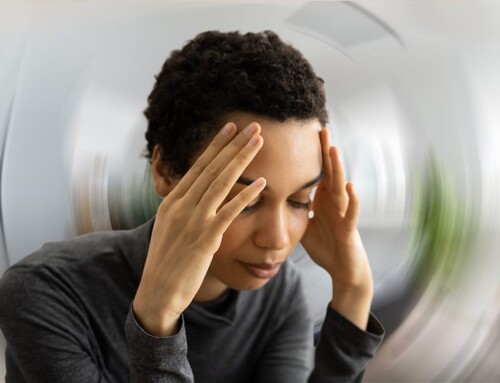Table of Contents
 Meniere’s disease is a condition of the inner ear that causes multiple symptoms including those listed below:
Meniere’s disease is a condition of the inner ear that causes multiple symptoms including those listed below:
- Tinnitus – a ringing in the ear
- Vertigo – the false sense that you or your environment is spinning
- Fluctuating hearing loss
Meniere’s commonly afflicts only one ear. The ears are responsible for our sense of hearing and keeping our balance. As many as 615,000 people in America have Meniere’s, according to the National Institute on Deafness and Other Communication Disorders. Most of those who are affected are adults between the ages of 40 and 50 years. People diagnosed with Meniere’s often go into remission a few years after their early diagnosis, but the disease can progress and result in permanent hearing loss if it is not cared for.
Symptoms of Meniere’s Disease
Besides tinnitus, vertigo, and hearing loss, other symptoms associated with Meniere’s include the following:
- Nausea and vomiting
- Abnormal headaches or migraines
- A feeling of congestion in the affected ear
- Loss of balance and coordination
- Sweating
Theories on the Cause of Meniere’s Disease
The exact cause of Meniere’s has not been determined by scientists and medical professionals. One existing theory, which has been widely considered for many years, is that Meniere’s is caused by an abnormal accumulation of fluid in the inner ear. How does this transpire?
The inner ear has sections called the labyrinth, containing organs of balance and organs of hearing. There are two parts: the bony labyrinth and the membranous labyrinth. The latter is full of endolymph fluid that fuels the receptors in the balance organs when the body is moving. These receptors refer messages to the brain about the body’s movements and where it is in its environment.
When Meniere’s arises, the endolymph build-up in the labyrinth does not drain appropriately and causes pressure. This hampers the standard balance and hearing signals between the brain and the inner ear. This results in vertigo and the other symptoms of Meniere’s.
Why this occurs is unclear. Some believe it is due to the same phenomenon that is involved in migraine headaches: the narrowing of blood vessels. Others think it is possibly a result of allergies, viruses, or autoimmune malfunctions. Genetics is another option as Meniere’s tends to run in families.
It is worth noting that many people living with Meniere’s have reported experiencing head or neck trauma in the past and have an upper cervical spine misalignment.
To learn more about the connection between head and neck injuries and vertigo download our complimentary e-book How to Naturally Relieve Vertigo without Drugs by clicking the image below.
The Root Cause of Meniere’s Disease According to a Recent Study
In 1999, a fascinating discovery was made regarding Meniere’s disease. Dr. Michael Burcon, a renowned upper cervical chiropractor, spearheaded a study involving Meniere’s patients. He reported that three of his patients with Meniere’s improved fast from their vertigo after receiving an adjustment from him. Their vertigo symptoms were completely gone. He noted a common denominator among his patients with Meniere’s disease: they all had previously had whiplash. He has successfully helped 725 cases of Meniere’s disease among his patients.
He shared in a video how more facts are being discovered about Meniere’s. Contrary to what was previously thought, Meniere’s is now attributed to a misalignment of the bones of the upper cervical spine, specifically the C1 and C2. A misalignment in these bones stresses the brainstem. That results in sending mixed signals to the brain about the body’s movement and location.
Another thing that develops when the bones are affected is they begin to generate a lesion affecting the Eustachian tube and the trigeminal ganglion. He clarified why this had not been discovered earlier. It is because it takes up to 15 years for the symptoms to develop. This explains why most patients get diagnosed during middle age, and they do not connect an accident that happened 15 years ago to be the source of the conditions they now have.
Another research study observed 300 individuals with Meniere’s disease who had all suffered whiplash from a vehicle accident. After getting specific upper cervical chiropractic care, 97 percent of them reported a massive decrease in their symptoms. Overall, all these patients shared that their vertigo, the major sign of Meniere’s disease, has improved by more than 90%.
Attaining Relief from Meniere’s Disease Naturally
The method we use here at Upper Cervical Hawaii, in Honolulu, is identical to the technique Dr. Burcon used in his study. Our upper cervical chiropractic care makes use of high-tech imaging and scientific measurements to locate the exact position of our patients’ vertebral misalignment. We then perform our mild and painless procedure to help the bones return to the correct place naturally. Our practice does not use the forceful techniques that some chiropractors use that result in popping or cracking. Our technique encourages a longer-lasting adjustment for fewer clinic visits in the future. Upper cervical chiropractic care is drug-free and doesn’t have harmful side effects. Nearly all our patients describe positive results similar to those in the studies mentioned above. If you are searching for a Honolulu chiropractor to help dispel your vertigo, we are happy to share our expertise. Once we’ve made our adjustments, expect your vertigo to decrease and eventually disappear. You can finally restore your happy and healthy life.
To schedule a consultation call 808-201-1324 or simply click the button below.
 If you are outside of the local area you can find an Upper Cervical Doctor near you at www.uppercervicalawareness.com.
If you are outside of the local area you can find an Upper Cervical Doctor near you at www.uppercervicalawareness.com.





